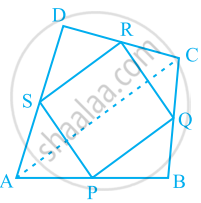Advertisements
Advertisements
प्रश्न
The figure, given below, shows a trapezium ABCD. M and N are the mid-point of the non-parallel sides AD and BC respectively. Find:

- MN, if AB = 11 cm and DC = 8 cm.
- AB, if DC = 20 cm and MN = 27 cm.
- DC, if MN = 15 cm and AB = 23 cm.
उत्तर
Let we draw a diagonal AC as shown in the figure below,

(i) Given that AB = 11 cm, CD = 8 cm
From triangle ABC
ON = `[1]/[2]` AB
= `[1]/[2]` × 11
= 5.5 cm
From triangle ACD
OM = `[1]/[2]` CD
=`[1]/[2]` × 8
= 4 cm
Hence, MN = OM + ON
= (4 + 5.5)
= 9.5 cm
(ii) Given that CD = 20 cm, MN = 27 cm
From triangle ACD
OM = `[1]/[2]` CD
= `[1]/[2]` × 20
= 10 cm
Therefore, ON = 27 - 10 = 17 cm
From triangle ABC
AB = 2ON
= 2 × 17
= 34 cm
(iii) Given that AB = 23 cm, MN = 15 cm
From triangle ABC
ON =`[1]/[2]` AB
=`[1]/[2]` × 23
= 11.5 cm
OM = 15 - 11.5
OM = 3.5 cm
From triangle ACD
CD = 2OM
= 2 × 3.5
CD = 7 cm
APPEARS IN
संबंधित प्रश्न
ABCD is a quadrilateral in which P, Q, R and S are mid-points of the sides AB, BC, CD and DA (see the given figure). AC is a diagonal. Show that:
- SR || AC and SR = `1/2AC`
- PQ = SR
- PQRS is a parallelogram.

ABC is a triangle right angled at C. A line through the mid-point M of hypotenuse AB and parallel to BC intersects AC at D. Show that
- D is the mid-point of AC
- MD ⊥ AC
- CM = MA = `1/2AB`
ABCD is a square E, F, G and H are points on AB, BC, CD and DA respectively, such that AE = BF = CG = DH. Prove that EFGH is a square.
Fill in the blank to make the following statement correct:
The figure formed by joining the mid-points of consecutive sides of a quadrilateral is
The following figure shows a trapezium ABCD in which AB // DC. P is the mid-point of AD and PR // AB. Prove that:
PR = `[1]/[2]` ( AB + CD)

In parallelogram ABCD, E and F are mid-points of the sides AB and CD respectively. The line segments AF and BF meet the line segments ED and EC at points G and H respectively.
Prove that:
(i) Triangles HEB and FHC are congruent;
(ii) GEHF is a parallelogram.
In triangle ABC, D and E are points on side AB such that AD = DE = EB. Through D and E, lines are drawn parallel to BC which meet side AC at points F and G respectively. Through F and G, lines are drawn parallel to AB which meets side BC at points M and N respectively. Prove that: BM = MN = NC.
In triangle ABC; M is mid-point of AB, N is mid-point of AC and D is any point in base BC. Use the intercept Theorem to show that MN bisects AD.
In ΔABC, AB = 12 cm and AC = 9 cm. If M is the mid-point of AB and a straight line through M parallel to AC cuts BC in N, what is the length of MN?
In ΔABC, D, E, F are the midpoints of BC, CA and AB respectively. Find DE, if AB = 8 cm
